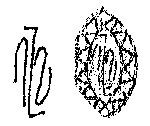|
|
|
|
|
||||
|
|
||||
| Two early writing systems, the
cuneiform of the ancient Near East and the hieratic form of Egyptian
hieroglyphics, figure prominently in the prehistory of the alphabet.
Egyptian hieroglyphics, which appear as early as 3000 BC, provide scarce
evidence of their prehistory. Cuneiform script , which competes with
Egyptian hieroglyphs for the claim to be the first form of writing, was
invented sometime between 3500 and 3100 BC.
In different forms the letters we recognize as the alphabet have been continuous use for more than three thousand years, and currently the alphabet is more widespread than any other system of written language. The basic principle of alphabetic writing is to represent a single sound of a spoken language by a single letter. There are more than few reports suggesting that the alphabet was probably invented between 1700 and 1500 BC by speakers of a Semitic language in the geographic area which serves as a bridge between the ancient civilizations of Mesopotamia and Egypt.
Ceramic Seal from 'Tserye'
 |
The Hittites, who spoke an Indo-European language and had a flourishing civilization in northern Syria and Asia Minor in the 3rd through 1st millennium BC, invented a hieroglyphic writing system of their own around 1500 BC. They also borrowed the cuneiform script of the neighboring Akkadians, but their hieroglyphic system, used until their civilization was conquered and absorbed after 600 BC, comprised approximately 400 signs which were not employed by any other people.
Similarly, several script systems on the island of Crete, which may have had their original inspiration from the idea of writing observed in contact with the Egyptians, share nothing either visually or linguistically with the hieroglyphics. The earliest of these Cretan forms are two pictographic scripts which developed around the palace at Knossos in 2000 BC, apparently followed chronologically by two linear forms, A and B, which are unrelated to each other. Of these, only Linear B (first developed around 1400 BC) has been deciphered. and that relatively recently by Michael Ventris. Ventris demonstrated that the script recorded an archaic form of the Greek language but with characters whose origins seem to have been indigenous to Crete. The pictographic and Linear A scripts do not record the Greek language, and they have not, as yet, been successfully deciphered. The use of Linear B for about two hundred years before the final destruction of Minoan civilization around 1100 BC (some four thousand clay tablets were preserved by their accidental firing in the blaze which destroyed the palace at Knossos) indicates that Greek administrators or rulers dominated the affairs at the Minoan capital in that period. Linear B was used mainly for keeping palace accounts of transactions, trade, and inventories. These Minoan scripts spread as far as mainland Greece and possibly Cyprus but their influence was limited both geographically and chronologically. The Cypriot syllabary shows the distinct visual characteristics of the Cretan scripts, and may have been brought to Cyprus around 1400 BC by the Mycenaeans. This script was used to record a non-Greek language and was clearly modified to record a different tongue.
|
Another seemingly independent invention also occurred in the Indus valley in the period around 2500 BC. Whether created in contact with other cultures who had their own writing system or from some individual inspiration, this script also vanished without development and the documents in this language also have yet to be deciphered.
The most interesting findings are coming from Macedonia where a round ceramic seal was discovered with inscription from 6000 BC ('Tserye' near village of Govrlevo , Skopje) , a bronze seal with similar inscription from 1500 BC ('Tserye') and rare inscriptions on the grave monument made on a rock.
According to Vasil Ilyov , author of 'Discoveries about the Literacy, Language and Culture of the Ancient Macedonians', the ceramic seal (as well as the rock inscription) was deciphered using modern Macedonian standard language with reading from the right to the left ! If you want to read more about it we have links to few articles on that subject from V.Ilyov.
One of the first historians to write about the history of the grammata or stoicheia, as the letters were called in his time, was the Greek historian Herodotus. Writing in the 5th century BC about the source of the alphabet, he described a process of fairly straight forward cultural borrowing: 'The Phoenicians who came with Cadmus ... introduced into Greece, after their settlement of the country, a number of accomplishments, of which the most important was writing, an art till then, I think, unknown to the Greeks. At first they used the same characters as all the other Phoenicians, but as time went on, and they changed their language, they also changed the shape of their letters.' Herodotus' comments on the Phoenician Cadmus found an echo on the later writings of Diodorus Siculus, who referred to the Phoenicians as the Pelasgi, or wanderers. Pelasgi were well known as a tribe on the Balkan but there had been neither artifacts nor linguistic evidence until now on which proto-alphabetic letter forms could be traced. Do we have the answer on the seals? |
||
|
|
||||
![]()
